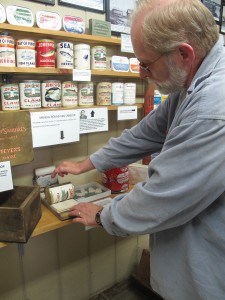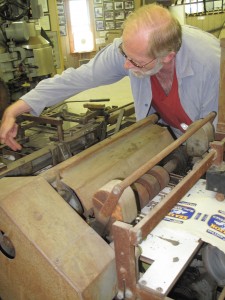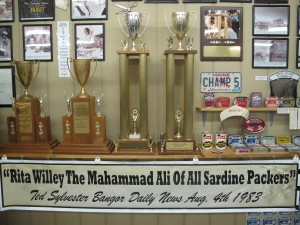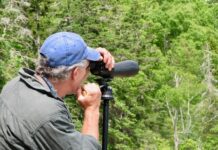UPDATE: The museum is permanently closed
—
I’m a sucker for small, focused, and quirky museums, and this gem, in Jonesport, Maine, sure fits the bill.
 Ronnie Peabody, executive director and co-founder of the Maine Coast Sardine History Museum, in Jonesport, reels off statistics about Maine’s sardine processing heyday. In the early 20th century, more than 400 factories salted the Maine coastline and this small down east town was home to 15 of them. “It was Maine’s largest industry,” he says, “and now, it’s gone.”
Ronnie Peabody, executive director and co-founder of the Maine Coast Sardine History Museum, in Jonesport, reels off statistics about Maine’s sardine processing heyday. In the early 20th century, more than 400 factories salted the Maine coastline and this small down east town was home to 15 of them. “It was Maine’s largest industry,” he says, “and now, it’s gone.”
Peabody grew up on neighboring Beals Island, which faces bridge-connected Jonesport across Moosabec Reach. His family fished herring and processed it, and he spent six years working in a packing plant. “Sardine processing is in my blood,” he says. “In my head, I can still hear the whistles blowing and sardine carriers running day and night; I still remember the smell of the places.”
 Peabody wondered if he could find enough artifacts and memorabilia to preserve the memories. In 2001, with the help of his wife, Mary, he began making phone calls and scouring the coast and pulling old equipment out of closed factories. “We sunk all our money into it, and then took out a loan,” he says. They acquired photos, machinery, original cans and labels, packaging, even shears from the skilled women who cut the fish.
Peabody wondered if he could find enough artifacts and memorabilia to preserve the memories. In 2001, with the help of his wife, Mary, he began making phone calls and scouring the coast and pulling old equipment out of closed factories. “We sunk all our money into it, and then took out a loan,” he says. They acquired photos, machinery, original cans and labels, packaging, even shears from the skilled women who cut the fish.
On July 4, 2008, the Peabodys opened the nonprofit museum in a purpose-built building adjacent to their home. Visitors punch in on a time clock, and can keep their card as a souvenir. After reading an overview, Ronnie lets them wander through the exhibits. While it’s possible to tour through the museum in 20 minutes or so without assistance, if you start peppering Ronnie with questions, it’s easy to spend an hour here.
Museum exhibits cover the entire process, from fishing for herring to processing then and canning sardines, the name for the finished product. “Originally all the cans were made by hand,” Peabody says, as he points out the soldiering and a tool dating from the late 1800s that was used to shape the metals. He explains the labeling machine, then points to the cans displayed, each with a distinctive label. “The labels are miniature works of art,” he says.
 The exhibit that gets the most attention is dedicated to Rita Willey, dubbed the “Mahammed Ali of All Sardine Cutters” in 1983 by the Bangor News for her consecutive titles in the early 1970s. She even appeared on the Johnny Carson show, Peabody says, his admiration for Willey obvious.
The exhibit that gets the most attention is dedicated to Rita Willey, dubbed the “Mahammed Ali of All Sardine Cutters” in 1983 by the Bangor News for her consecutive titles in the early 1970s. She even appeared on the Johnny Carson show, Peabody says, his admiration for Willey obvious.
NOTE: The Maine Coast Sardine History Museum is open late June through late September, as well as Memorial Day weekend and on summer holidays.













